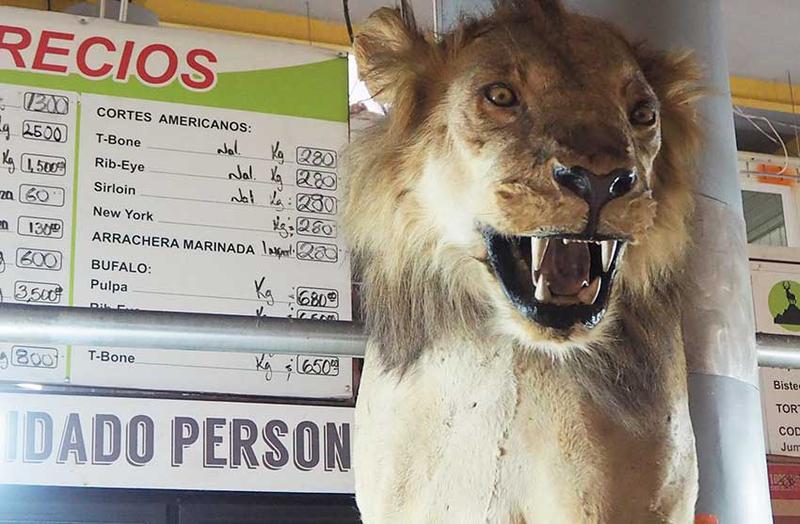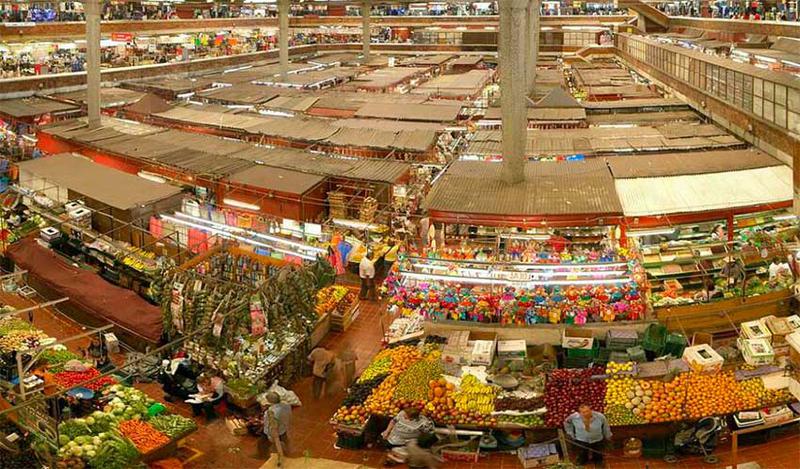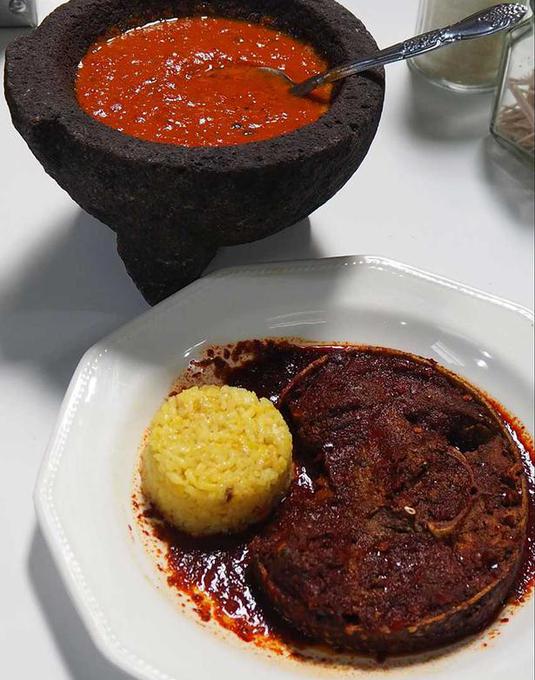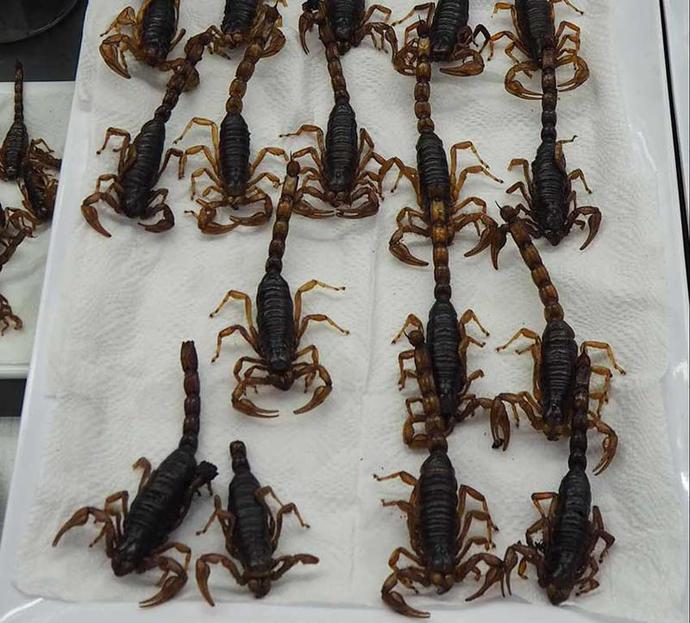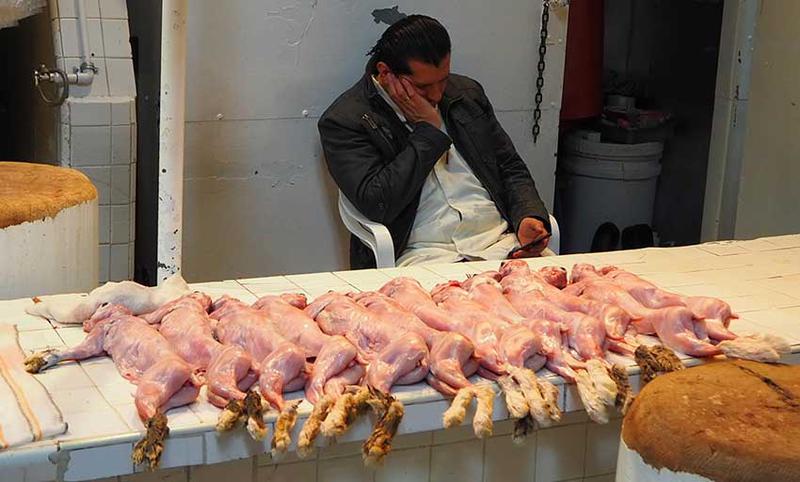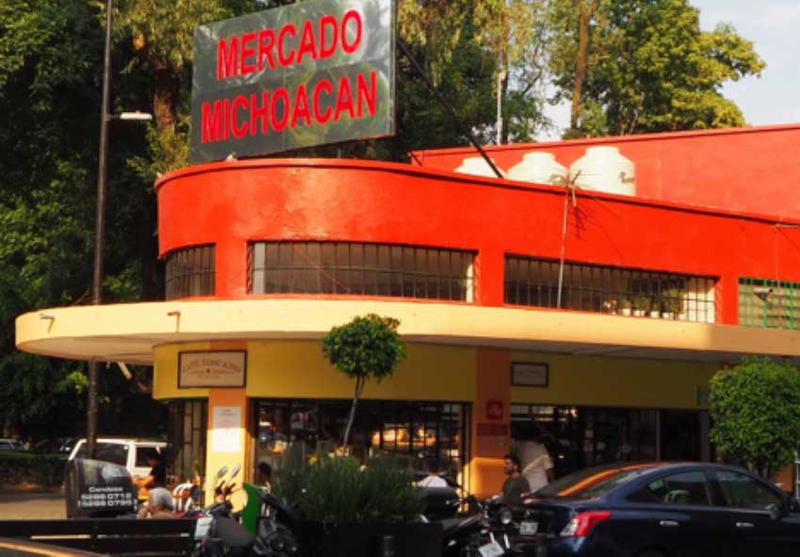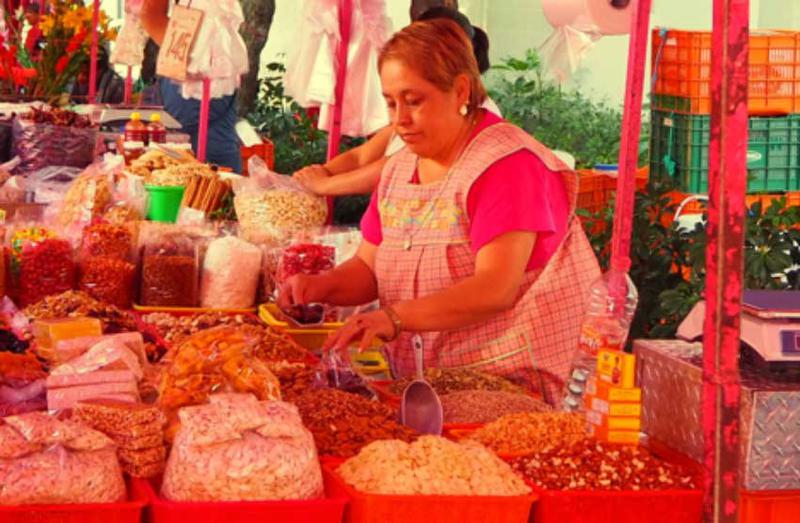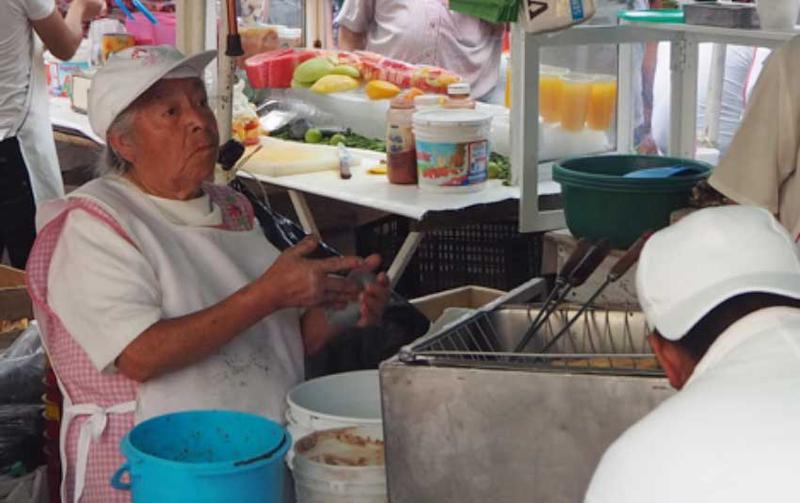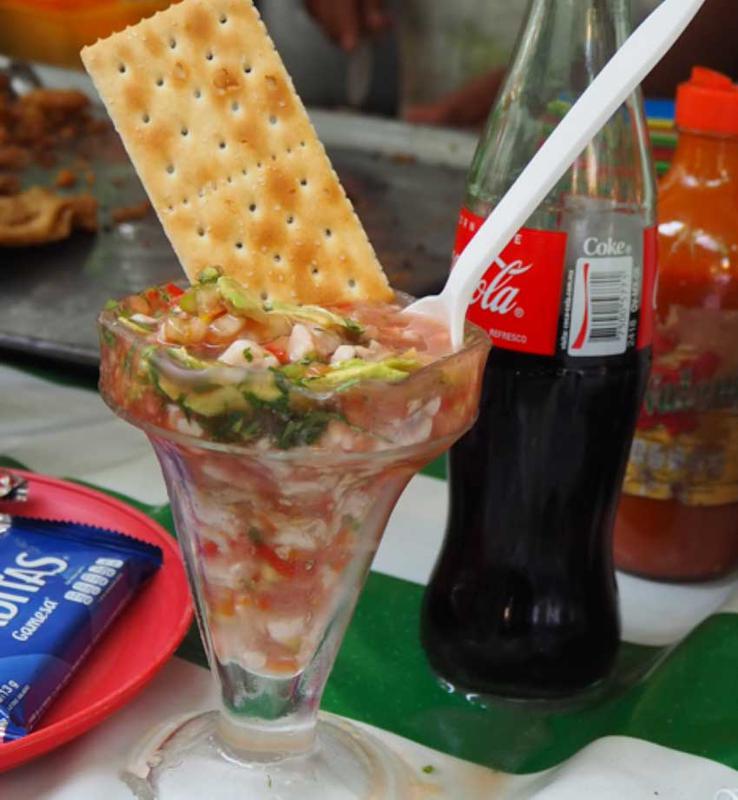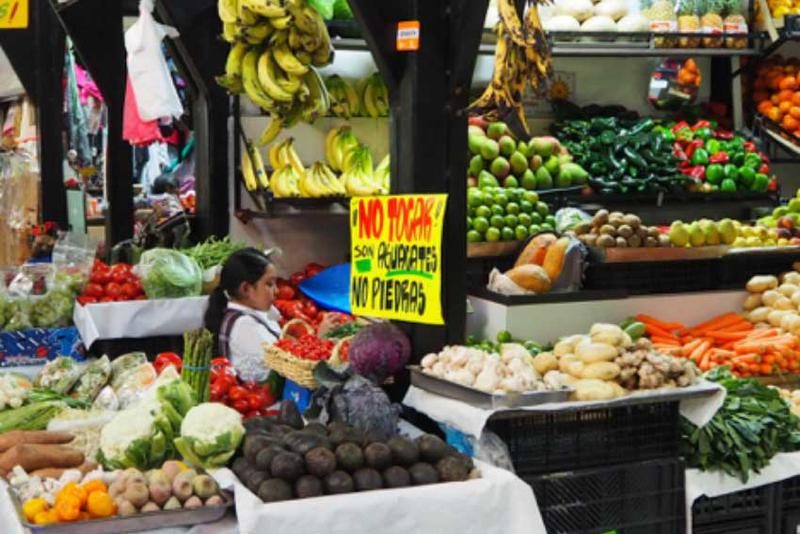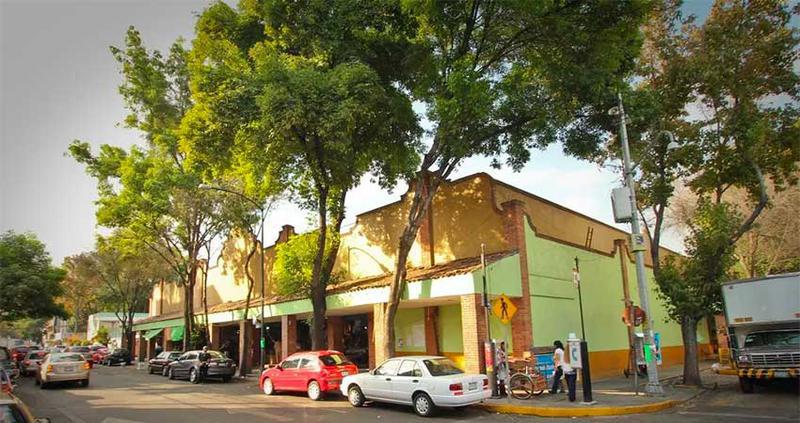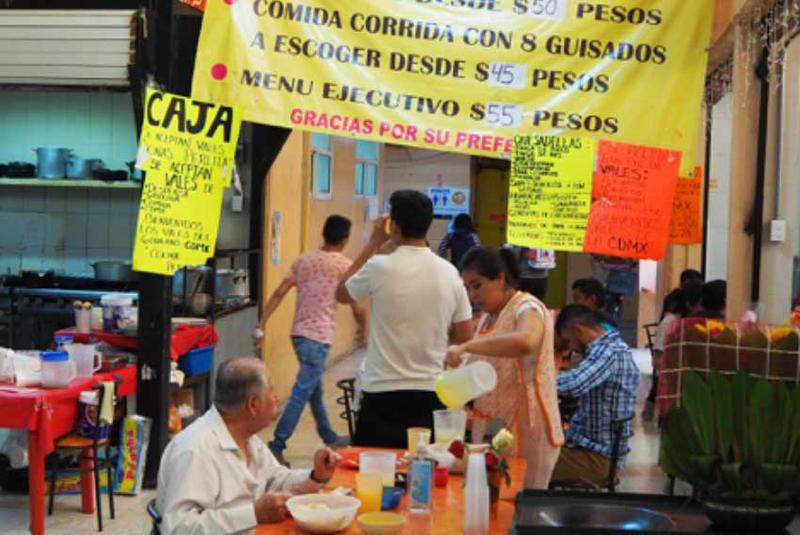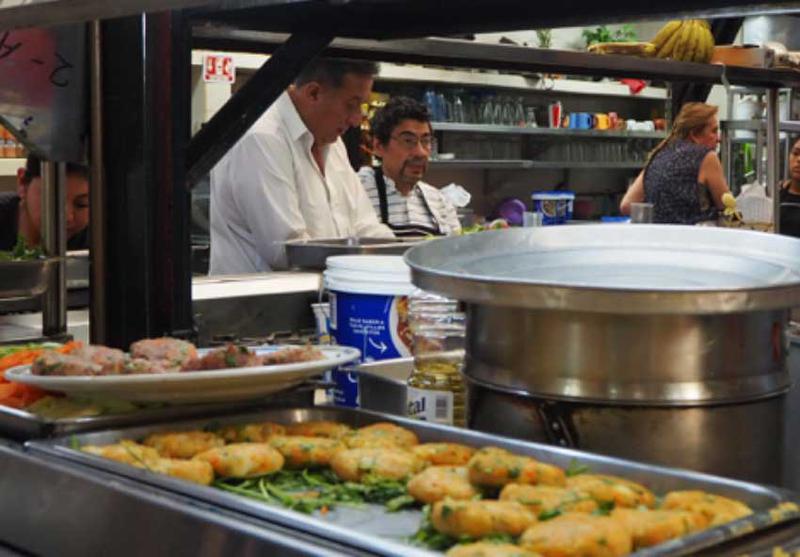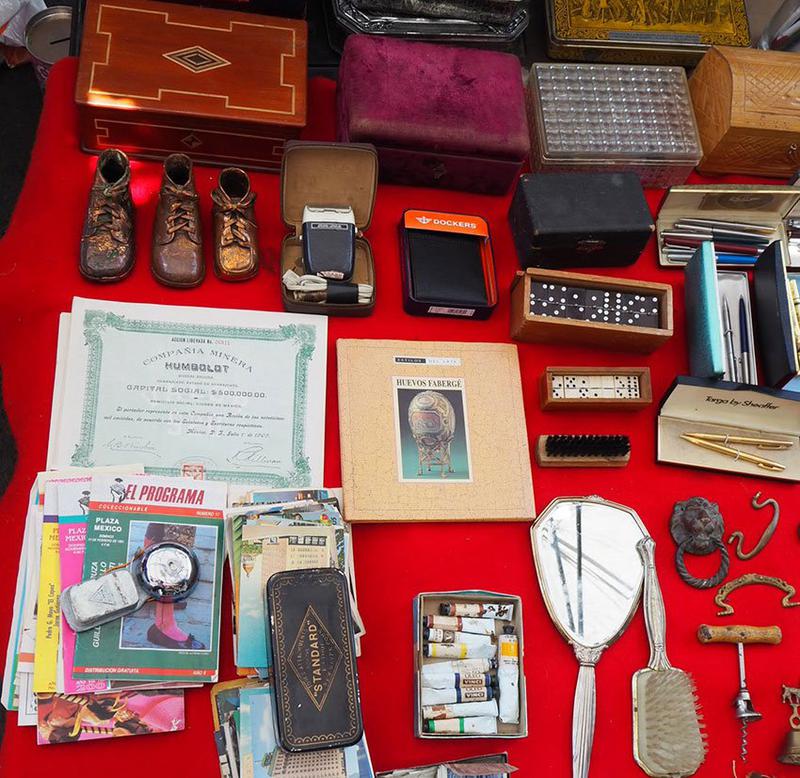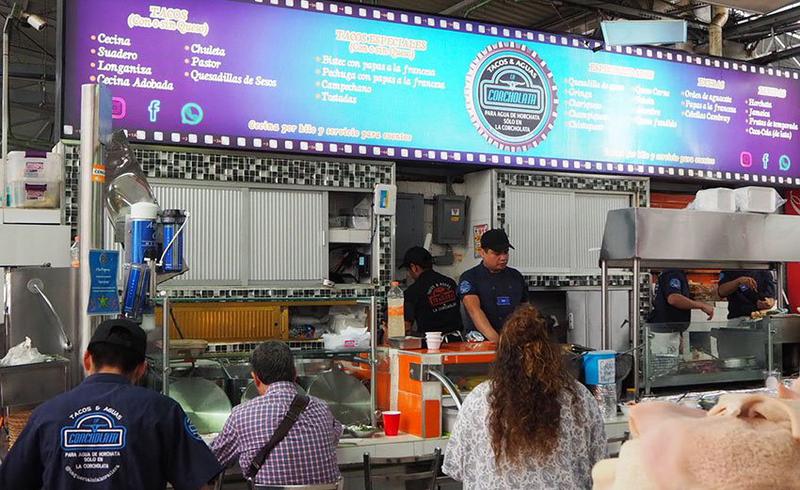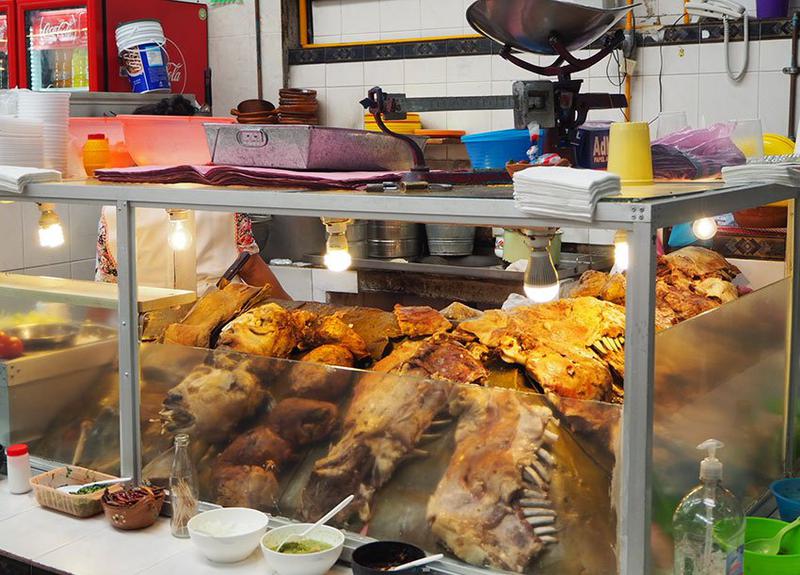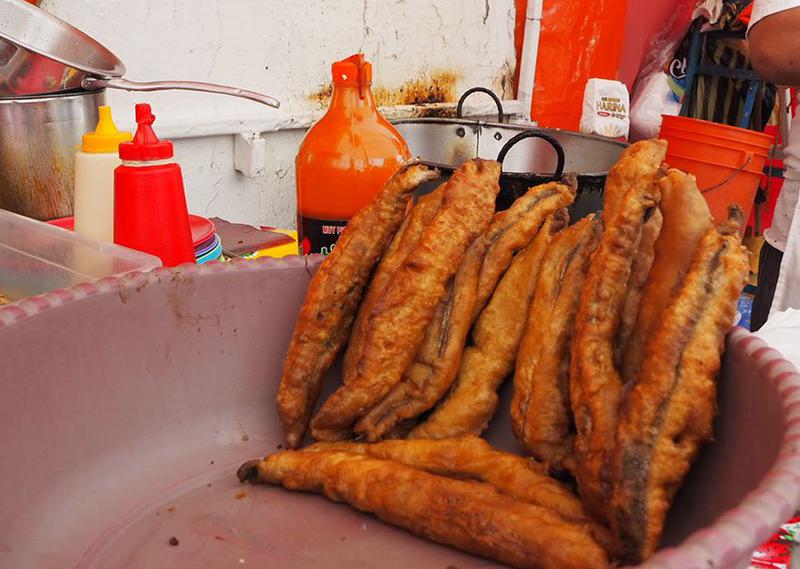#1 The San Juan Market - Calle Ernesto Pugibet 21, Colonia Centro
Fancy some lion for dinner? You can find it at the San Juan market.
The San Juan market, Mexico City’s epicenter for culinary inquisition
You'll find gastronomic delicacies from lion and tiger meat to crunchy bugs and gooey worms
By Andy Hume
Wednesday, March 13, 2019
“Hello, friend. What do you want to eat? Crocodile, lion, armadillo, iguana, ostrich?” runs the vendor mantra at the Mercado de San Juan in Colonia Centro. The framing and countertops of each stall are decorated with the heads of their prey – capybaras, tigers, kangaroos and buffalo – their flesh long since consumed.
A ragtag brass band walks slowly, hat out for tips, through the rainbows of fruits and vegetables, European cheeses and cured meats, dried insects, skinned rabbits and goats, mountains of obscure sauces, and an entire ocean of fish, crustaceans and bivalves.
Built in 1955 on the former space of the Buen Tono cigarette warehouse and officially titled Mercado de San Juan Ernesto Pugibet after the land’s former owner, the building is one of the oldest municipal markets in Mexico City, and its common name comes from the nearby San Juan Plaza, where food vendors sold their wares beginning in the early 1900s.
The market is renowned worldwide for its rare array of gastronomic delicacies: items uniquely Mexican and strange to the rest of the world and others seldom seen in Mexico, imported from distant locales. And then, of course, there are tiger steaks and lion burgers – among some of the scarcest of meats, raised legally on farms in Puebla and Guerrero.
Food tourists ogle, sniff and poke; their taste buds stoked, cameras cocked and ready, as they vacillate at countertops, anxious for the sensual experience of the virgin tongue.
The San Juan Ernesto Pugibet market has more than 350 vendors.
Martha Marín Marín, proprietor of La Sorpresa restaurant – staffed today with her daughter Jessica at the grill and son Aarón waiting tables – says it takes a special sort of interest to sample lions and tigers. They’re the strongest of the meats, and she doesn’t sell them much. They have to be cut into extremely thin slices and marinated in herbs and olive oil, then either grilled or pan seared in garlic olive oil to cut the overwhelming flavor.
Marín has owned La Sorpresa for 20 years but first started working at the market at the age of 12 when she would travel to the city on school breaks from Valle de Bravo to stay with her sister, who got her a job as a dishwasher.
“Tourists come from Sinaloa, Colombia, the U.S., China, Japan, Italy, all over,” Marín explains. “A lot come with guides who explain the food in their own language. The most popular we sell are crocodile, armadillo and wild boar. I try everything, but my favorites are venison, armadillo and wild boar.”
The latter doesn’t quite tick the exotic box. But an anteater in a shell, part rodent part rhinoceros, seems sufficiently weird. So I go with the armadillo, the “little weaponized one.”
A serving of armadillo, marinated and wrapped in plastic, comes out of the freezer and into a frying pan. Most of the exotic meats are frozen because they’re not selling dozens of armadillos a day. It’s served steaming hot, the meat stained red from the pepper marinade, with a distinct, smoky aroma that tingles the nose.
“Armadillo a los tres chiles” is marinated in guajillo, pasilla, and morita peppers and served with a side of rice and tortillas. It’s a small, round slab of the animal, cut from spine to belly with the carapace shell still intact.
Three-chile armadillo at La Sorpresa restaurant
At first bite, I’m a little skittish to be peeling a mammal’s shell before slicing its flesh with my knife. Yet, after a single swallow holds, I can enjoy for taste alone. I realize the meat is more tender as I move toward the center, away from the carapace.
I see what appears to be a spine but no visible organs. It’s an interesting experience eating an animal cut all the way through from abdomen to back, as if sliced into pieces by a cartoon samurai. “I special order these cuts,” Marín explains. “They’re cut into medallions with a deli slicer. They have more meat and fat. When they’re cut into strips, there’s more bone.”
The flesh is lean and flavorful, with a slight, sweet liver taste but not too gamey, requiring a bit of knife work but not overly chewy – sort of like a porky rabbit. The peppers add a perfect saline and smoke flavor. “It can be made with more peppers,” Marín tells me, “but for me, this is the best combination.”
Marín talks like a woman that is used to this, like she’s been on TV. A documentary crew passes, panning the camera over stuffed animal heads. A man sits next to me and is served a simple consommé, while I request the provenance of my fried armadillo.
“I don’t know exactly where they come from,” Marín tells me. “I get them from different purveyors that work with farms throughout Mexico, but I don’t know what part of the country each animal is from.”
Jessica teases her brother out of boredom as he tries to get butts in seats for a bite of iguana. A tour of Americans passes learning about bugs. A well-behaved and manicured German family scans the vegetarian section with its mounds of mushrooms, blazing pink and yellow tropical fruits, unknown nuts and the mostly northern tree fruits and Asian vegetables that are often hard to find in Mexico.
You can eat the tails of the small scorpions, but it’s not recommended to eat the tails of the big ones.
The selection varies greatly depending on the season, with late fall among the most exciting for the wide variety of wild mushrooms coming in from the hinterlands. I tell a woman pushing persimmons that I’m a journalist and ask if I might be able to question her. She’s not at all interested, with a response that tells me she gets this request quite often.
Instead, she offers up her colleague, Claudia Barona of Rosse Gourmet, a gracious and eloquent host, well-versed in the historical significance of her offerings, many of which have been fundamental parts of the local diet for millenia.
She makes a clear point that, although they are a central ingredient to modern Mediterranean and European cuisines, tomatoes didn’t arrive in Spain and Italy until the 16th century.
I learn that tomatoes are thought to have first been cultivated by Mexican ancestors as early as 700 AD, originally as tomatillos, eventually growing into their sweeter, redder cousins that we we know as the modern tomato. In Mexican Spanish the word tomate is what we call “tomatillo” in English (coming from Nahuatl word tomātl, “swelling fruit” or “fat water”), while what Mexicans generally call jitomate is actually “tomato” in English (from Nahuatl xitomatl, loosely, “swelling fruit with a navel”). And Barona is delighted to point out that aguacate (avocado) is a Spanish bastardization of the Nahuatl word āhuacatl, meaning “testicle.”
For foreigners, she says, huitlacoche is one of her most frequent sales. Called the “Mexican truffle,” huitlacoche is a microfungus that grows within the cell walls of corn kernels to produce a blue-black powdery flesh, unlike mushrooms that are macrofungi and have their own multicellular fruiting structures.
Huitlacoche has a mild, semi-sweet, nutty, umami flavor – equal parts sweetcorn and mushroom – and is a common ingredient in quesadillas, tamales and scrambled eggs, turning to a dark black color when cooked.
Doña Martha Marín and her daughter Jessica at La Sorpresa.
“When mushrooms have a strong smell, it often means that they’re good and ready to eat,” Barona tells me. “But when huitlacoche starts to smell strong, it means it’s going bad and shouldn’t be eaten.”
Barona hands me a sample of a small tuber called papa de agua or oca that looks like a hard, bright red caterpillar and grows in shallow, slow-moving rivers and streams (hence, the name “water potato”). They’re common from Jalisco to Hidalgo and the mountains of Colombia and Peru, and are a traditional food source of the areas. They taste a bit like an apple, sweet and slightly acidic, usually eaten raw or roasted with poultry.
She points out the rábano arcoiris as a more popular delicacy among her Mexican clientele. Literally translated as “rainbow radish,” but more commonly known as “watermelon radish” in English due to its green skin with white flesh turning to dark red as it approaches the center. I recognize the watermelon radish as a common garnish among modern elite diners and their chic restaurants of choice.
As well as a popular destination for culinary tourists, San Juan Market is often mentioned as a favorite foraging spot for local chefs of international renown, so I assume Barona’s Rosse Gourmet would be frequented by the upper echelons of Mexico City culinarians. However, when I ask if “chefs” come to purchase from her she gives me a curt, “No” (a response that I understand to be a rejection of a word that, to her, denotes “white-jacketed, social-climbing snob”).
“Only tourists buy. They come with tours or by themselves to try new things,” she continues. (Or it could be that I am just one in a long line of foreign journalists obsessed with the circumstance and celebrity of 21st-century food culture and am simply cliché.)
At the far edge of the market hang pink muscled goats, lambs and deer, butchers working to free them of their internal organs. Gutted piglets lie together in rows, each one’s legs spooning its brother to the front, eyes closed, as if dozing the afternoon away.
Taking a break from skinning rabbits.
Fuzzy rabbit feet peek out from under towels, the rabbits appearing to be piled in a cuddle underneath, until the realization hits that, apart from the feet, they’re skinned bare.
Next come rows of insects laid out on plates: chocolate covered chicatana ants, scorpions in lollipops, dried beetles and cockroaches and piles of seasoned maguey worms and grasshoppers, most of which have been regular protein sources for millenia. Tourists squeal and wince as they munch on crunchy bugs and fat, gooey worms, the vendors egging them on for personal delight.
At the restaurant México en el Paladar, I talk to José Carlos Camacho who tells me that the grasshoppers are the most common at 80 pesos for 60 grams, while the “tarantula tasting with a salad accompaniment” is the priciest at 500 pesos. You can get 10 scorpions for 250. A taco filled with dozens of whole, tiny crayfish, called acociles, costs 45. And a serving of one of Mexico’s most treasured delicacies, the buttery, melt-in-your-mouth escamol (chicatana ant eggs), will set you back 200 pesos.
For those with an affinity for the European diet there are countless tapas stalls, deli cases filled with cheeses and pâtés and hanging dried sausages and hams, begging to be plucked from their hooks. Among the most visited is Tapas de San Juan, where meat and cheese tapas, or a baguette sandwich, will run from around 150 to 400 pesos. It seems expensive until you realize that you won’t be charged for any wine until you’ve reached at least the fourth glass.
Shared seating on plastic stools and pallet benches around a table spread of flavored oils, herbs, marmalades and salsas makes for a good excuse to meet new friends. The sandwiches are large and the wine is flowing, so come with friends or be prepared to make new ones.
I decide on a domestic foie gras that is quite good, despite the overabundance of aspic, the thick, congealed meat jelly that often surrounds a pâté. I pick at the delicate pieces, not quite hungry: a fussy little foodie, teasing foie gras around his plate.
I chat with a British woman, new to the city, who is out designing a food tour for English-speaking visitors. We exchange notes on the market, speaking from a polite distance, despite the loud prog and psychedelic rock coming from the speakers. I make a note to visit the domestic specialty wine and beer shop in the back corner, though I never make it. Our glasses are filled dutifully, and I realize it’s nearly closing time.
As San Juan Market begins to close, there’s a comforting rowdiness in the air. The patrons have drunk abundantly at the wine, beer and mezcal, and vendors pop open Modelos and Tecates while they squeegee and wipe. Piles of skin bits, fish heads and animal feet wait to be bagged up and sold elsewhere.
I ask a woman wiping down the a fish counter if I may ask her a few questions. She points to a gray, crotchety, old man, gesticulating wildly at a friendly-looking couple dressed in light, wicking travel gear. “That’s the guy you need to talk to. He does all the promotion,” she says with a smirk. “But right now he’s talking politics.”
The documentary crew passes, scanning close-ups of an icy pile of enormous shrimp. The fishes still present are beautiful, hulking specimens; only fresh raw seafood, no prepared foods in sight.
When he has finished chatting, I meet Sergio Martínez, who’s owned El Puerto de Santander fish stall for seven years. His family has been in the fish business for over 100, when his grandfather’s brother had bodegas in the city. He began working under him as a kid and has been selling at San Juan Market for 59 years straight.
He tells me the róbalo (sea bass) is the most popular and his personal favorite because you can prepare it however you want, and it’s always delicious. In ceviche, grilled or fried it will be good. “In general, Veracruz has the best seafood,” he tells me. “But the pulpo [octopus] is best from Campeche, and the best langosta [lobster] comes from the Gulf.”
I bring up the global popularity of the market. “Who are your clients?” I ask. “Is it locals, food tourists?”
“Tourists don’t buy,” he tells me. “People that buy from me come from a certain sector of society. The ones that like high quality. The cost is pretty high to produce and source good quality, and some don’t want to pay. If you want good quality, you have to pay.”
I mention the tapas, that they seem expensive until you account for the copious wine pours. “How much does good wine cost?” he asks. “That’s not good wine they’re serving.” He doesn’t care for the prepared foods. “It loses what it is to be a market,” he says.
“I saw the old generation. They made everything themselves. It’s symbolic what these so-called restaurants pay the government for their stalls. When the market started, they weren’t selling any prepared foods. It’s not hygienic to cook in the market. These aren’t real restaurants.”
I get on my highfalutin horse again and ask about Mexico City chefs. “Chef,” he says with crystal-clear disdain, shot point-blank. “There are great cooks that come to buy from me. Some work in restaurants. But chefs? There are more gastronomy schools than medical schools here in Mexico these days. They are afraid of math and chemistry, so they go to cooking school!”
• Mercado de San Juan is located at Calle Ernesto Pugibet 21, Colonia Centro, Mexico City; open Monday through Friday, 9:00am to 5:00pm.
This the first in a series exploring the numerous, diverse markets and tianguis (markets on wheels) of Mexico City.
**************************************************
THE MARKETS OF MEXICO CITY
Mexico News Daily - - by Andy Hume
#2 La Condesa - Campeche from Saltillo to Ometusco and Ometusco to Nuevo León
La Condesa’s only permanent market, Mercado Michoacán.
A walk through the Mexico City markets of Colonia La Condesa
Mercado Michoacán and the Tuesday and Friday street markets are three to see in the Condesa neighborhood
By Andy Hume
Wednesday, March 20, 2019
If you like to explore or shop in Mexico City’s numerous and diverse markets, the Condesa neighborhood offers three.
In downtown Condesa which, by the way, must be the electric scooter app capital of the world, is the tiny Mercado Michoacán, a beautiful art deco building shared with one of the city’s many iterations of Café Toscano and surrounded by the pearls of modern suburbia: Wing’s Army, 7-11 and Panam Shoes.
Aside from the nearby El Centenario cantina, Mercado Michoacán is one of La Condesa’s few older businesses to survive into the 21st century. It’s definitely worth a stop in for the gringas and sopes, but Michoacán really only provides the basics: you’ve got your chicken guy, your beef guy, some general stores and fruits and veggies.
It’s always surprising there isn’t a larger market in Condesa but maybe Mercado Escandón supplies the need. At Frutería las Delicias, Camelia Ferreyra Olivares tells me that it’s mostly neighbors that come in or visiting foreigners.
“Restaurants will come to buy,” she says, “if they run out of something. But they have distributors, so they don’t buy from us regularly.”
• Mercado Michoacán is at the corner of Tamaulipas and Av. Vicente Suárez.
Every Tuesday, just blocks from Chapultepec Park, on the western edge of La Condesa lies the grande dame of Condesa-area street markets – Tianguis Condesa, the Condesa Tuesday Market.
Running along quaint Pachuca, lined with lush trees and quintessentially picturesque Mexico City architecture, Tianguis Condesa is a foragers’ paradise.
It’s best to come early, when the morning sun still feels good, before it gets too hot and the crowds form. The international food tours are ubiquitous, with foreigners learning about strange new fruits.
Melon and papaya pushers hand out samples and a hard sell, alongside vendors of clothing, cosmetics and housewares, all glowing pink under the CDMX-issued market tarps.
But the vegetables are the best reason to come, some of the most perfect produce you’re likely to find in the area, much of it sourced just outside of the city and likely picked only the day before.
Lilia Hernández has been selling fruits and dried nuts at the market for 40 years.
• Tianguis Condesa runs along Pachuca from Veracruz to Juan de la Barrera from 10:00am to 5:00pm every Tuesday.
On the other end of Condesa, right of to the side of busy Avenida Nuevo León, is the Condesa Friday Street Market, where the atmosphere is thoroughly upbeat. It’s Friday, very likely payday, and the clientele appear to be feeling fine.
Every tiny plastic stool is occupied at the counter of the simply named Barbacoa, known for its barbacoa flautas and a variety of sopes, quesadillas and tacos.
A spunky gray-haired woman in a double smock, plain white over pink gingham, multi-tasks throughout the stand, quick on her feet – patting out tortillas, wiping down tables, taking orders. It’s incredibly crowded, but even if you can’t find a stool, you’ll be able to eat on your feet at Barbacoa.
The flautas are perfectly golden with the crunch that tells you they’re fresh, topped with crema and queso fresco. Don’t be shy with the salsas – there are buckets full of them behind the counter.
Local workers on lunch break and visiting tourists are the bread and butter of most street market restaurants, and they visit this tianguis about 50/50, I’m told. Rodrigo Reyes, who works in an office nearby, tells me, “We come every Friday to fill our stomachs before going out for drinks after work.”
The Doña holding it all together at Barbacoa at the Condesa Friday Street Market.
Right behind Barbacoa, Pescados y Mariscos Los Pescaditos is almost equally busy. The fish cocktail “with everything” (meaning extra cocktail sauce, cilantro and avocado on top) is a perfect balance of lime, spice, crunchy bell peppers and a touch of extra sweetness.
Another specialty is the caldo de camarón, a deep red shrimp broth with plenty of richness to line the belly for a night on the town.
Moving away from the food vendors is a bit more of a local scene. At Ian Toys, Alejandro Mendoza washes a newly acquired action figure in a bucket of soap.
He’s been selling at the market for 20 years and specializes in older collectibles, like favorite superheroes and Star Wars and Jurassic Park figurines.
“Mostly adults buy the toys because kids are only into tablets these days — iPads,” he says, guessing that his clientele is about 80% adults and 20% kids.
“Kids don’t want to play with dolls,” he says with a smirk. “Some of my clients come about every week. I’ve had some clients for over 10 years, since they were kids.”
The beautiful fish cocktail from Los Pescaditos at Condesa Friday Market.
Most of the vendors move throughout the city, selling at a different street market every day, and despite Condesa’s fame as one of the city’s major tourist zones, I’m told sales are pretty equal on any given day.
But Tianguis de los Viernes is the fun one because everyone’s in a weekend kind of mood.
• Tianguis de los Viernes runs along Campeche from Saltillo to Ometusco and along Ometusco to Nuevo León every Friday until 5:00pm.
This is the second in a series on the markets and weekly tianguis (markets on wheels) of Mexico City.
**************************************************
#3 Escandón Market - Calles José Martí and Agricultura
Escandón Market is quintessential middle-class CDMX neighborhood market
Corruption has held back improvements but vendors do a brisk business
By Andy Hume
Fresh-cut flowers, fried fish, incense and salon perms – the smells of the neighborhood market. Put a 100-peso bill to your nose, it’s all there.
The newest Marvel movie plays on a flat screen, while a little girl in a plaid skirt works on her homework below, eyes jumping between screen and page. Butchers smack their cleavers into chicken and beef. Sewing machines and blenders whir. Commerce.
Right at the center of the blissful, upper-middle-class, family-oriented neighborhood of Escandón, just below Jardín Morelos Park, sits Mercado Escandón.
A trip to the Escandón Market is worth it for the regular stuff you might need throughout the week, if only to avoid the pain and confusion of a nearby Soriana Hiper – where first you lose your cart, then you lose your mind.
At the market entrance on Martí, friendly Emilio Flores Romero has been selling children’s costumes at his booth with no name for 20 years.
Escandón Market in Miguel Hidalgo
He has a wide selection and says people come from all over to buy, “for birthday parties or just because they like to dress up,” he says. “Right now we’re selling a lot of animals and butterflies, because Día de la Primavera [the first day of spring] is coming up.”
Plumbers and handymen have offices at Mercado Escandón. There are flower arrangers, toy salespeople, religious goods and free parking! It’s downright wholesome. Escandón is the only market I’ve ever been to that gives you a city-issued legal receipt for your five-peso bathroom purchase.
Just don’t forget that this is Mexico, and the vendors are still lamenting the loss of 40 million pesos that the government allocated for renovations in 2013, half from the Office of Economic Development (SEDECO) and half from the borough of Miguel Hidalgo.
And what have they done? Barely fixed the roof? Improved the parking garage? Where did the money go? Many point the finger at then delegate and current mayor Víctor Hugo Romo, claiming he simply failed to use the money for improvements.
The roof still leaks in places, and there’s a pretty major crack in the ceiling of the bottom level of the parking garage.
Unfortunately, there are no improvements in sight. Yet, as they continue to fight alleged corruption, vendors continue to do what appears to be a brisk business.
La Perlita has the best flautas in the market and you can pay with gasoline vouchers
At the popular lunch stand Los Tucanes, known for enchiladas, croquettes and huge chiles rellenos, where a full meal with an agua del día, consommé, rice and salad runs 50 to 70 pesos (US $2.60-$3.60), I meet Miguel Ángel Sánchez, who’s worked at the market for 32 years.
His family has been in Escandón for generations, and his father was one of the founders of the market when it began in 1958. “My dad sold fruits and vegetables before the market was here. People sold out of carts or on blankets. There weren’t any supermarkets, so people came together to sell in this spot.”
Undoubtedly the most popular restaurant, that can be quite the party on weekends, is Marisquería Playa Escondida. Their marlin, shrimp and scallop cocktails are the visible favorites, but the encrusted tuna or grilled salmon steaks are probably among the best you’re likely to find.
Escondida is one of the few consistently full counters and the only place you’re likely to see anyone drinking a michelada on a Monday.
There are always a number of locals enjoying the wares, but the nearby Hotel & Villas Patriotismo brings in a steady line of tourists from Europe and South America.
Mercado Escandón isn’t the weirdest or fanciest of Mexico City’s markets. In fact it’s the market’s ordinary, no-nonsense posture that makes it so enjoyable.
Miguel Ángel Sánchez takes a quick break after the lunch rush at Los Tucanes
The consistent line in front of Pollería Zani tells you it’s good. Maybe not the cheapest fruits and vegetables you can find, but they’re always available. And you’re likely to get some extra service, like a bit of manteca rubbed on your freshly cut steak to keep it moist on the grill.
As Miguel Ángel Sánchez tells me, “Supermarkets changed our local markets a lot, but here you can still get meats and fish with less preservatives. It’s more natural.”
• Mercado Escandón is located on the corners of José Martí and Agricultura, Colonia Escandón, Mexico City; open Monday through Sunday, 8:00am to 8:00pm.
• Every Tuesday on José Martí, just east of the market, runs Tianguis Escandón, an extended “market on wheels” from 8:00am to 6:00pm.
This is the third in a series on the markets and weekly tianguis (markets on wheels) of Mexico City.
**************************************************
#12 Portales Antiques Flea Market - on Calle Rumania
No one knew how to use these giant ice chests that were for sale at the Portales Antiques Market.
From knick-knacks to treasure maps at Portales Antiques Flea Market
It's not the best antiques market in Mexico City but it's open every day and offers plenty of gems
By Andy Hume
Chácharas – trinkets, knick-knacks, curios, bric-a-brac, junk or simply, stuff – are the talk around Tianguis de la Portales in the northern end of Mexico City’s Colonia Portales.
They say one man’s trash is another man’s treasure, and they have, perhaps, said this more than anything else about the Portales Antiques Flea Market.
But if you’re a sucker for tiny collectables like pewter animals, pins, wick lighters and decorative tins, then Tianguis de la Portales is the place for you. A severed toe key ring for 70 pesos? Sure. Why not.
Portales’ short, one-block flea market isn’t consistently the best antiques market in the city, but it’s open every day and there are still plenty of gems to keep regulars coming back. It’s like a giant garage sale spilling out on to the street and worth a special stop or a quick visit whenever you find yourself around the neighborhood.
Piles of used clothes beg to be dug through in search of the valued label here and there. Used washing machines and refrigerators, tools, some beautiful furniture (and much of questionable value) – you could furnish an entire house from this block of Calle Rumania, though its presentability may depend on the day you arrive.
You can find a decent deal on used stereo equipment at the market.
Many passing through appear to be book collectors, hoping to eye some 100-year-old title that may have snuck by the vendor’s watch.
The street market opens at 8:00am, but sales don’t get into full swing until around 11, so it’s delightfully reasonable to arrive around midday, unless you’re an antiques shark who wants to be the first to see each new product.
Some of the most amusing pieces are the electronics and appliances from the 60s, 70s and 80s that quickly anachronized with the changing times, like the enormous ice chests for 2,000 pesos that no one really understands how to use.
Or a cassette and LP boombox that the vendor assumes is in working condition but doesn’t have the proper power cord to plug it in – it’s going for 300, but she’ll give it to you for 200.
Roberto Aguilar tells me he’s been selling for 37 of the approximately 70 years the street market has been running here. He doesn’t specialize in anything, kind of whatever comes by, and usually gets his items in bulk lots when someone sells their house. “Or [when] a lot of people are dying, too,” he says.
Most of the vendors say that framed pictures, lamps and light fixtures are the most sought after by clientele, although the latter seem to be in short supply today. There are boxes of old photos to sift through for an imagined guess into the lives of the long dead, shoes, handbags, weird and creepy figurines, typewriters and a number of collectible toys.
The author’s severed big toe (plastic) key chain. He passed on the finger and baby toe.
Marcos Maldonado’s stand goes a bit more down the path of the legitimate antiques dealer: watches, jewelry, eyeglasses and pins from the mid to early 20th century. He reckons his oldest items are the clothing irons from around 1900 that are priced between 400 and 800 pesos (US $21 – $42).
He gets his product everywhere from metal recyclers pulling carts in the street to his personal clients that are always on the lookout for special items. But the estate sales are where the good money is because you can buy an entire room full of items, or an entire house.
Sometimes a particularly valuable piece of jewelry will come up, and he recalls once buying a huge panoramic photo of Mexico City from around the time of the Revolution. He made a lot of money on that one.
Portales is a great place for the vintage audiophile, with used stereo equipment for fairly cheap, as the home stereo goes the way of the typewriter. Giant name brand speakers from the 80s and 90s for 500 to 1,200 pesos – a great deal provided they work, as promised – and used records in good shape for 20 to 30 pesos.
Around the corner on Libertad are some of the nicer jewelry pieces and antique home goods. Intricately hand-carved vintage ivory earrings for 400 pesos seems to be a reasonable deal. Some vendors keep their truly special items hidden away, awaiting the collectors.
Vintage shop owners pass through, searching for the hip item du jour to fill their shelves. And new product continues to arrive throughout the afternoon, as cars pull up to their chosen vendors and open their trunks to show the goods. You can make a few passes and see something new each time.
A government stamped mining certificate from 1908 among other collectibles.
Maria de Jesús Romer sells out of a garage she rents on Rumania, as do many vendors. It must be quite the time saver not to have to drive the product in every day. She tells me sales have gone down the past couple of years.
“It used to be people looking for finer stuff, more antiques,” she says. “At the same time, it’s hard to find good stuff these days, real antiques. Because a lot of people have passed away or given their antiques to their children,” thus making room for the glut of DVDs, computer monitors, scanners and VHS players – the antiques of tomorrow.
Due to all the vendor traffic and traffic from the nearby Mercado Portales, it’s worth taking public transportation or walking to avoid the mess.
After the tianguis walk a few blocks to the enormous Bazar Reto showroom (Fernando Montes de Oca 391) for the beautiful antique furniture. It’s a bit pricier but in great shape. And there are plenty of chácharas to wade through upstairs.
• Tianguis de Antigüedades de la Portales is located on Calle Rumania, between Libertad and Calzado Santa Cruz, Colonia Portales/San Simón, open Monday – Friday, 8:00am to 6:00pm.
This is the 12th in a series on the bazaars, flea markets and markets of Mexico City:
**************************************************
Mercado Martínez de la Torre
You'll find pulque by the liter at La Frida, one of the attractions at the Martínez de la Torre market. You'll find pulque by the liter at La Frida, one of the attractions at the Martínez de la Torre market.
You'll find pulque by the liter at La Frida, one of the attractions at the Martínez de la Torre market.
Mercado Martínez de la Torre one of the best food markets in Mexico City
With around 600 stalls, the market is the cultural and economic center of Colonia Guerrero
There’s a comforting middle-class, almost suburban feel at Mexico City’s Mercado Martínez de la Torre in Colonia Guerrero.
On any given afternoon, the market’s surrounding holes-in-the-wall cantinas are populated mostly by men in the laid-back stepdad look of plaid shirts tucked into comfortable jeans with cell phone holsters and tennis shoe/hiking boot hybrids.
Traffic blasts by on Eje 1 Norte, and a few blocks off the market can get a little sketchy, but it’s all full bellies and family smiles between Zarco and Calle Soto.
With around 600 stalls, Martínez de La Torre Market is the cultural and economic center of Colonia Guerrero and one of the best food markets in the city, often overlooked by non-locals.
The symphony of scissors snipping chickens into vendible pieces and the smell of piles of ripe guava make their way into the market’s exceptionally wide walkways – a gawking tourist’s dream. The quality of meats and sausages is way above par, and there are mountains of excellent moles to choose from.
The bustling counter at famed Tacos y Aguas La Corcholata
You can safely get lost wandering the abundance of delicious flavors, but we’ve picked out some particular culinary gems at Mercado Martínez de la Torre.
Taquería Lola La Trailera & La Corcholata
Why settle for just one name, when you can have two? Named for actress friends of the taquería’s owner, “Lola the Truck Driver,” played by Rosa Gloria Chagoyán, and “The Bottle Cap,” played by Carmen Salinas, La Corcholata is the most publicized eatery in the market and run as such – super attentive staff with pressed uniforms and name tags.
The buttoned-up look is a little out of place in Guerrero, but it runs like a well-greased plancha. Their cecina tacos are not to be missed. But the local favorites are the beef or chicken tacos with French fries, to fully absorb the salsa verde, and a perfectly sweet and frothy horchata to balance the salt and heat.
Taquería “El Mejor” Barbacoa de Horno
You don’t have to wait until the weekend for barbacoa at Mercado Martínez de la Torre, and their name is accurate – El Mejor is truly the best barbacoa in the market.
The mutton case at Taqueria “El Mejor” Barbacoa de Horno
The slow oven-roasted mutton is brought in daily from Mexico City’s agrarian outpost, Milpa Alta – the city’s southernmost borough known for its sheep, both in the oven and on the pasture.
Ignacio Ramírez has manned the butcher block at El Mejor since 2000, and his barbacoa comes off the knife appropriately tender and stringy with the deep buttery, only slightly pungent, flavor of a properly roasted mutton.
A Coke, barbacoa taquito and a bowl of consommé for only 50 pesos is a wonderful pick-me-up any day of the week.
Carnitas La Güera
Over 60 years in, and La Güera’s crispy carnitas pork bits are still one of the best reasons to come to the market.
Take home a giant, half-a-pig-sized chicharrón or just sidle up to the counter for a quick taco. La Güera won’t let you down on the pork front.
Delicious, greasy, whole fried sierra at Ocotlán.
Ocotlán
Just outside the market entrance on Zarco is the tiny fried fish stand, Ocotlán. The fish – Mexican sierra – are in the mackerel family, and come breaded, whole. They’re about the size of a toothpaste tube, like a giant greasy sardine, and wrapped in paper to go. Or enjoy them hot, on the spot with a bit of mayo and hot sauce.
Eskimoz y Raspados Sonia
The blenders buzz non-stop at Sonia, the ideal last stop for the sweet tooth on the Martínez de la Torre tour. Their nostalgic milkshakes and shaved ices will warm your heart and cool your core on a hot day. Or go nuts with a fruit frappe rainbow of your design.
Pulquería la Frida
If you’re looking for a drink of the alcoholic variety, head across Mosqueta/Eje 1 to La Frida for a pulque – the drinking person’s milkshake. The viscous, fermented agave sap beverage provides a distinctive tingly buzz. Pulquería la Frida is a tiny, single room in bright pink, yellow, and green, providing a no-nonsense pulque experience – loud music, pulque, and beer – because who wants nonsense?
While the banner promotes over a dozen sweet and savory flavors, they’re likely to have only a couple in stock. Try celery or oatmeal flavored for something delicious and mellow. Or go native with the natural flavor, and ask for some baking soda to shake into it (for the extra bubbles) if you’re really looking to impress.
Watch traffic whizz by out of the open doors and enjoy your pulque in a cracked glass, for that truly authentic feel.
• Mercado Martínez de la Torre is on Eje 1/Mosqueta, between Calle Soto and Zarco. Some stalls open as early as 7:00am, with most open until 6:00pm.
This is the 11th in a series on the bazaars, flea markets and markets of Mexico City:
**************************************************
For more in this series click: Mexico Ctiy Markets - part 2
